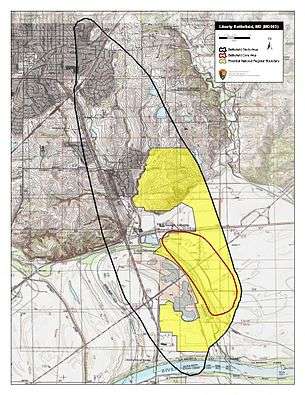Battle of Liberty
| ||||||||||||||||||||||||||||||||

The Battle of Liberty (also known as the Battle of Blue Mills Landing or the Battle of Blue Mills) was a battle of the American Civil War that took place on 17 September 1861, in Clay County, Missouri.[1] Union forces unsuccessfully attempted to prevent pro-Confederate Missouri State Guards from northern Missouri from crossing the Missouri River near the confluence with the Blue River to reinforce Sterling Price at Lexington.
Background
After his victory at Wilson's Creek in August, Price began a campaign to gain control of Missouri. Union troops had been guarding the Hannibal and St. Joseph Railroad and its terminus in St. Joseph, Missouri. When these Union forces were pulled away to meet Price's army, Confederate sympathizers from northwestern Missouri seized St. Joseph and sacked the town.
On 15 September, about 3,500 men of the Missouri State Guard plus a number of irregulars from St. Joseph set out for Lexington. In the evening, Price sent ex-Senator and now General David Rice Atchison from Lexington to help these men, mostly new recruits, cross the river near Liberty.
Union troops of the 16th Illinois Infantry and the 39th Ohio Infantry were guarding the Platte River railroad bridge in Buchanan County, which had earlier been sabotaged in the Platte Bridge Railroad Tragedy. These troops started moving to Liberty. At the same time, Union Lt. Col. John Scott led a small force (500 men of the 3rd Iowa Infantry, about 70 Missouri Home Guards, and one 6-pound smoothbore cannon) from guarding the railroad at Cameron towards Liberty. Heavy rain and bad roads limited his progress to only seven miles that day. On 16 September, Scott camped in Centreville (ten miles north of Liberty), where he heard artillery fire in the distance.
The battle
Lt. Col. Scott broke camp at 2:00 A.M. on 17 September. He arrived in Liberty at 7:00 A.M., and sent scouts out to find the enemy. Skirmishing began about 11:00 A.M. At noon, Scott marched five miles in the direction of the firing, and approached Blue Mills Landing on the Missouri River.
General Atchison, who had lived in Liberty, deployed his men in the brush on either side of the Missouri River bottom land road leading to the landing. At about 3:00 P.M., Scott's troops encountered the State Guard pickets and were attacked from both sides.
Scott's artillerymen fired two rounds of canister, inflicting heavy damage. However, a fresh volley from the State Guards scattered or killed most of the gunners. Scott ordered his outnumbered force to fall back to the bluffs in Liberty, hauling off the gun by hand. Atchison attempted a flanking movement on the Federal right, which resulted in a sharp fight. The Union force continued to withdraw, firing as they retreated, taking with them nearly all their wounded, but abandoning their ammunition wagon and a caisson. The State Guard pursued for some distance, but Atchison did not press the attack.
Just before nightfall, Scott's force retired to Liberty, entering the town about an hour after sunset. Atchison and the State Guards from northern Missouri crossed the river to reinforce Price in his successful attack on Lexington. After sunset the Union troops returned to retrieve their dead from the field.
Union troops set up a hospital on the campus of William Jewell College in Liberty and buried their dead on the campus.[2]
Casualties
The fighting at Blue Mills Landing lasted for an hour and resulted in a total of 126 casualties. The Union forces suffered 56 casualties and the Missouri State Guard lost 70. Among the latter was the Missouri State Guard's Theodore Duncan, who died on the same day that he had been promoted from captain to colonel. Ten of the sixteen Union field officers fell dead or wounded.
References
- 1 2 3 4 National Park Service battle description
- ↑ History of Clay and Platte Counties, Missouri. St Louis: National Historical Co. 1885. pp. 208–219. Retrieved 17 September 2016.
- U. S. War Department, The War of the Rebellion: A Compilation of the Official Records of the Union and Confederate Armies, 70 volumes in 4 series. Washington, D.C.: United States Government Printing Office, 1880–1901. Series 1, Volume 3, Part 1, pages 193–195.
External Links
Coordinates: 39°11′35″N 94°23′03″W / 39.1931°N 94.3842°W